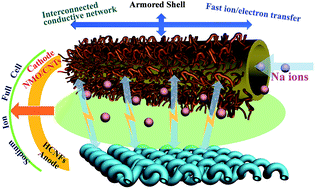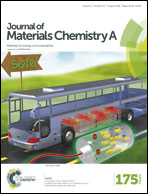A CNT cocoon on sodium manganate nanotubes forming a core/branch cathode coupled with a helical carbon nanofibre anode for enhanced sodium ion batteries†
Abstract
The commercial advancement of high-performance sodium ion batteries is highly dependent on the judicious design/construction of advanced electrode materials. In this work, we construct novel P2-type Na0.7MnO2.05 nanotube/carbon nanotube (NMO/CNT) core/branch composites via a powerful three-step process for sodium ion battery (SIB) applications. P2-type Na0.7MnO2.05 nanotubes of about 500 nm have been, for the first time to our knowledge, fabricated and further modified by cocoon-like CNT branches. The cycling performance is increased significantly with an encouraging capacity retention of 88% at 0.1 A g−1 after 100 cycles due to enhanced electrochemical kinetics and improved structural stabilization resulting from the CNT cocoon branches. To assess the practical functionality as a full cell, a helical carbon nanofibre (HCNF) anode with capacitive-dominated sodium ion storage is also developed to match with the NMO/CNT cathode. The new-type NMO/CNT//HCNF full cells exhibit encouraging cycle performance with a capacity retention of 71% after 200 cycles at 100 mA g−1 and superior rate performance to the unmodified NMO//HCNF full cells. Our electrode design strategy provides a new way for fabricating high-performance electrode materials for SIBs.

- This article is part of the themed collections: JMC A Editor’s choice collection: Recent advances in batteries and 2016 Journal of Materials Chemistry A HOT Papers

 Please wait while we load your content...
Please wait while we load your content...